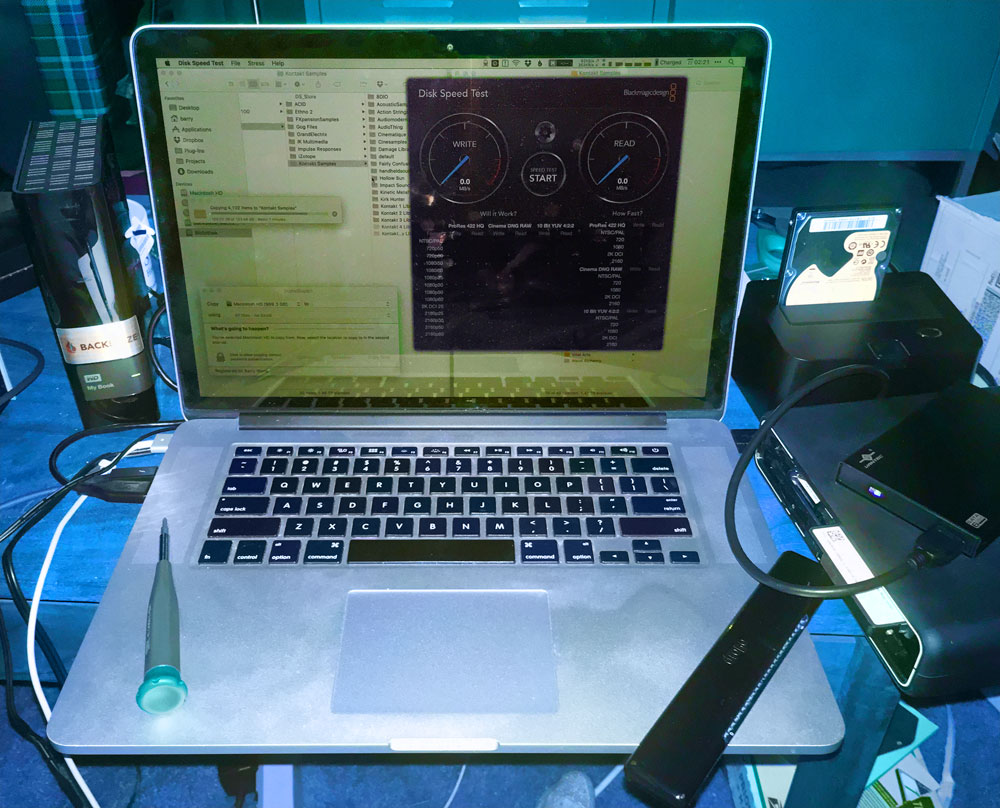External Storage - A Story of Death and Rebirth

Introduction
When I was transitioning to a laptop I knew that I needed substantial external storage. Sample libraries, loops, impulse response files, virtual machines, and audio project archiving eat up several terabytes pretty quickly. For the last two years I've been using a device called the Drobo Mini. It's an asymmetrical, proprietary RAID system that utilizes 2.5" drives. I had mine loaded up with four 2TB drives and a 128GB MSATA solid state card for caching. I was generally happy with the performance but did have some high track count, high sample rate projects that had trouble playing from the Drobo Mini. In those cases I put the projects on the 1TB SSD on my Macbook Pro's motherboard and they were fine.
The Conflict
What I really liked was the fault-tolerant nature of RAID, that is, until it failed. After about two years I had one of the bays indicate a failed drive. No problem, this sort of thing happens. I purchased a couple of new drives and popped one in. A week later a second bay showed a failed drive, this time however the new drive I replaced it with also showed failure. Not out of the realm of possibility but after swapping drives around and doing further testing it appeared that it was the Drobo and not the drives that was failing. I was still able to access my data though due to the redundant nature of RAID. I hit the local Fry's and picked up a 4TB USB drive so I could get a backup of everything on the drive but about two-thirds of the way the backup the Drobo decided that two of the four drives were bad which took it offline.
Bad News
I contacted Drobo support and was told that I would have to pay $49 for a support incident before anyone would talk to me. They did however tell me that if it was found that the Drobo Mini was bad, my only recourse would be to purchase a new one. Oh and by the way, that's now a legacy product (even though it was still on their website). That exchange ended my relationship with Drobo.
Good News
Fortunately I didn't rely exclusively on the RAID saving my data, I've used computers for far too long for that. For a number of years I've been using Backblaze to backup all of my data to the storage pods in their datacenter. For $189 I had them ship me a USB drive with all of the data from the Drobo. As soon as I'm done with the drive I ship it back and they will credit my account the $189. That's customer support.
The Problem
I still needed to figure out what do with my data. One of the things that I didn't like about the Drobo was that it had internal fans, which is understandable since there were four mechanical drives in there that needed cooling. That added ambient noise while I was recording so I often kept current music projects on my internal SSD and left the Drobo powered down. The only trouble was if I needed access to samples libraries or impulse responses I'd have to have the Drobo powered up.
The Solution: Part 1
Half of my new solution was comprised of purchasing a Newertech Voyager S3 drive dock. I could use the 2TB drives from the defunct Drobo Mini as backup drives and I could use them to store multiple copies of my project archives. I could also maintain the cloud backup of these files via Backblaze. What's even better is that Backblaze fingerprints each file that it's already backed up so it recognizes that it already has copies of these files so no massive re-upload was required.
The Solution: Part 2
I wanted to have easier (and silent) access to my sample libraries and impulse responses so I looked into large capacity SSD drives. At this point in late 2016 I found that the cost of 2TB SSD drives were actually cost-effective. Through Pricewatch I found a 2TB Crucial SSD drive that cost substantially less than two of the least expensive 1TB SSD drives. I figured that a Thunderbolt drive enclosure would be what I needed get the best performance out of the SSD. I couldn't find any empty single-drive external Thunderbolt enclosures out there but I did find one with a 1TB hard drive. I benchmarked the Thunderbox box with the mechanical hard drive and the read/write performance was in the neighborhood of 115MB/s. After swapping in the SSD (and voiding the warranty in record time) the performance went up to 350MB/s. I was feeling pretty good about this, until…
The Surprise
I inserted the unused 1TB mechanical drive into the drive dock and it was still benchmarking at around 115MB/s. This was not particularly surprising because I expected that the drive transfer speeds were the bottleneck. I decided to see what USB3.0 was made of and put the SSD into the drive dock. Surprisingly it measured 412MB/s for writing and 381MB/s for reading. I hadn't expected the performance of USB 3.0 to outstrip Thunderbolt but there it was. Another quick trip to Fry's for an under $20 USB3.0 enclosure and the more expensive Thunderbolt box will soon be winging it's way back to it's Amazonian homeland.